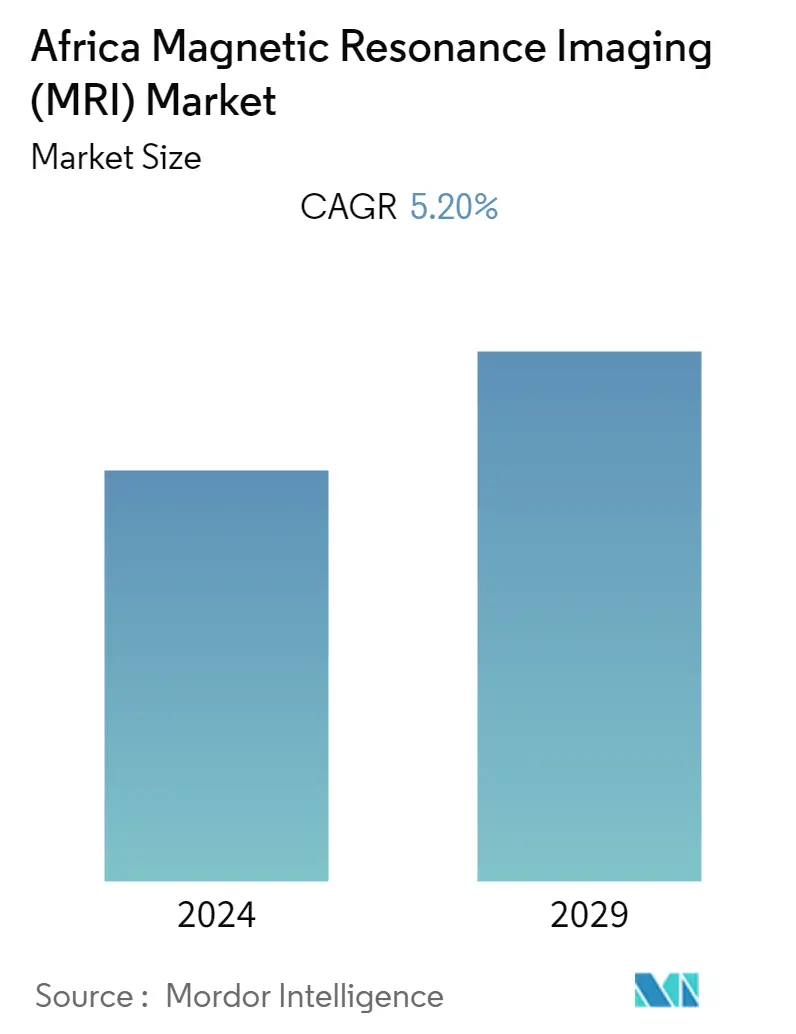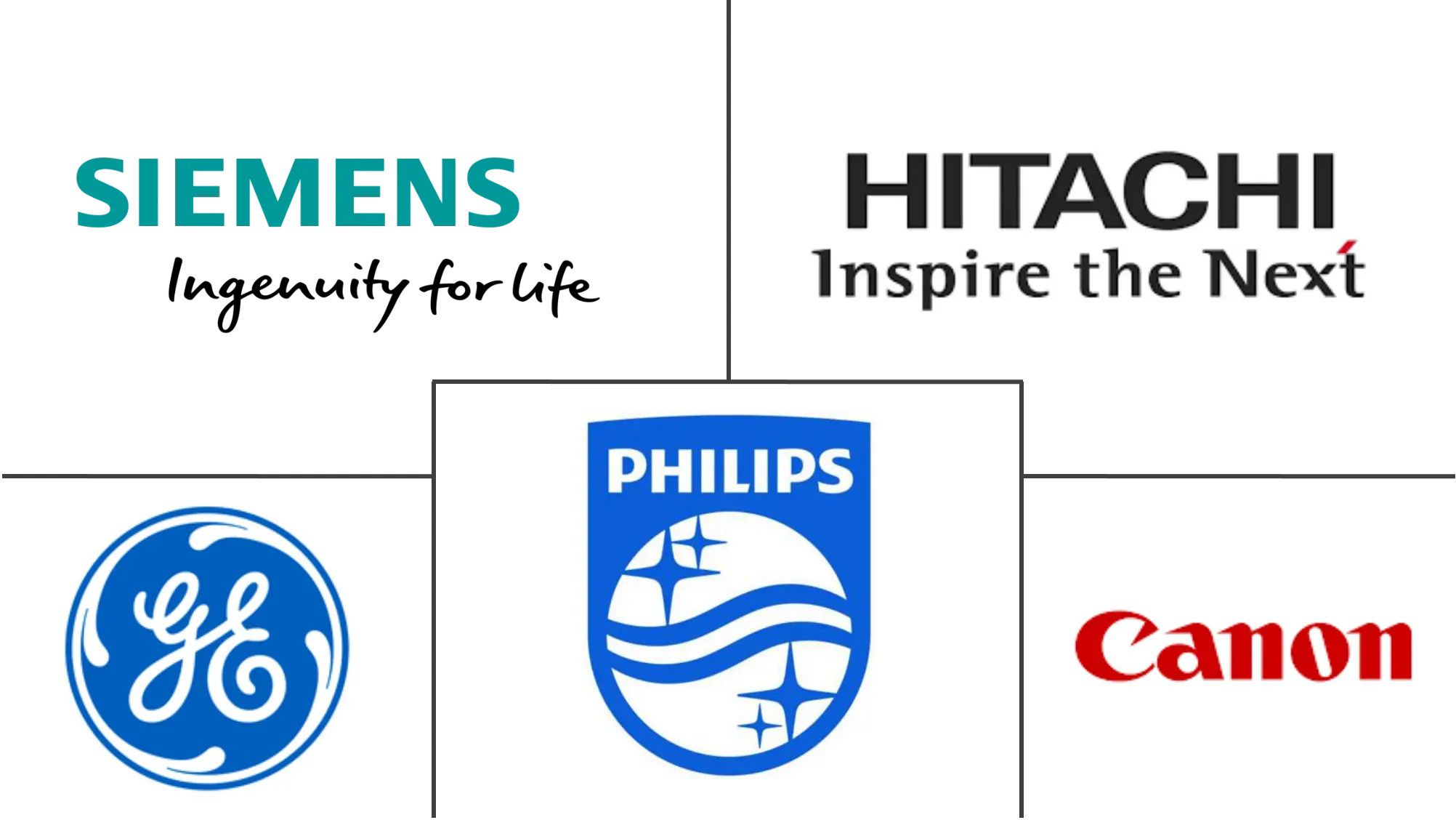Market Size of Africa Magnetic Resonance Imaging (MRI) Industry

| Study Period | 2019 - 2029 |
| Base Year For Estimation | 2023 |
| Forecast Data Period | 2024 - 2029 |
| Historical Data Period | 2019 - 2022 |
| CAGR | 5.20 % |
Major Players
*Disclaimer: Major Players sorted in no particular order |
Africa Magnetic Resonance Imaging Market Analysis
The African Magnetic Resonance Imaging Market is expected to register a CAGR of 5.2% over the forecast period.
The COVID-19 pandemic has rendered a severe impact on the African magnetic resonance imaging (MRI) market. The article published in Springer Journal in March 2022 mentioned that during the COVID-19 outbreak in Africa, there were limited human resources, patient overload, and outdated equipment in Africa. The article also mentioned that limitations for infection prevention and control measures coupled with lower vaccine coverage and uptake, efficiency timeliness, and equitability of imaging services had been compromised in Africa. Thus, the COVID-19 pandemic had a notable impact on the MRI market in Africa during the initial stages of the pandemic. However, the relaxation of the strict lockdowns in Africa is expected to regain the pace of Africa's MRI market growth over the forecast period.
The key factors propelling the growth of the African magnetic resonance imaging market are increasing chronic disorders among the African population and rising technological advancement, such as the inclusion of MRI with PET or CT, to provide imaging possibilities with less exposure to harmful radiation. For instance, the article published in Global Heart Journal in January 2021 mentioned that the overall prevalence of multimorbidity from chronic conditions in the Sub Saharan Africa was 28.7%, and the most prevalent diseases were HIV (12.1%), tuberculosis (10.9%) and diabetes (1.8%). Additionally, the article published in NCBI in June 2021 mentioned that the overall prevalence of coronary heart disease and stroke in South Africa was 1.29% and 4.29%, respectively. Such prevalence of chronic diseases among the African population is expected to drive the demand for effective and early diagnosis with MRI, thereby boosting the market's growth.
Moreover, increasing market strategies such as collaborations and partnerships by various key market players to provide advanced diagnostics are also expected to contribute to the market's growth. In August 2022, the Institute of Human Virology in Nigeria (IHVN) entered into a partnership with Fujifilm, and Qure.ai, to help optimize Tuberculosis (TB) screening outreach in Nigeria using imaging diagnostic services. Thus, such developments and partnerships lead to technological developments in the region, thereby fuelling the studied market.
Thus, due to the aforesaid mentioned factors, such as increasing chronic disorders and rising demand for effective and advanced diagnosis, the market is expected to witness significant growth over the forecast period. However, the high cost of magnetic resonance imaging (MRI) systems may slow down its growth over the studied period.
Africa Magnetic Resonance Imaging Industry Segmentation
As per the scope of the report, magnetic resonance imaging is a medical imaging technique used in radiology to produce pictures of the anatomy and the physiological processes of the body in both health and disease. These pictures are further used to diagnose and detect the presence of abnormalities in the body.
The African Magnetic Resonance Imaging (MRI) Market is segmented by Architecture (Closed MRI Systems and Open MRI Systems), Field Strength (Low Field MRI Systems, High Field MRI Systems, Very High and Ultra High MRI Systems), Application (Oncology, Neurology, Cardiology, Gastroenterology, and Other Applications), and Geography (South Africa, Egypt, Nigeria, Kenya, and Rest of Africa). The report offers the value (USD million) for the above segments.
| By Architecture | |
| Closed MRI Systems | |
| Open MRI Systems |
| By Field Strength | |
| Low Field MRI Systems | |
| High Field MRI Systems | |
| Very High and Ultra High MRI Systems |
| By Application | |
| Oncology | |
| Neurology | |
| Cardiology | |
| Gastroenterology | |
| Other Applications |
| Geography | |
| South Africa | |
| Egypt | |
| Nigeria | |
| Kenya | |
| Rest of the Africa |
Africa Magnetic Resonance Imaging (MRI) Market Size Summary
The African Magnetic Resonance Imaging (MRI) market is poised for growth, driven by increasing chronic disorders and technological advancements in imaging techniques. The market experienced a setback due to the COVID-19 pandemic, which highlighted challenges such as limited resources and outdated equipment. However, the easing of lockdowns is expected to restore growth momentum. The rising prevalence of chronic conditions like HIV, tuberculosis, and diabetes, coupled with the integration of advanced technologies such as MRI with PET or CT, is anticipated to boost demand for effective and early diagnosis. Market strategies, including collaborations and partnerships, are further expected to enhance diagnostic capabilities, contributing to the market's expansion.
The oncology segment is projected to witness significant growth due to the rising number of cancer cases and technological developments in diagnostic facilities. The high incidence of cancers, such as breast and prostate cancer, underscores the demand for MRI in effective diagnosis. Advanced technologies, including those integrated with artificial intelligence, are expected to facilitate early detection of cancer, further driving segment growth. Egypt is expected to be a key driver of the market, supported by a high burden of chronic diseases and a growing geriatric population. The establishment of new diagnostic facilities and the launch of advanced radiology services are likely to bolster market growth in the region. The competitive landscape is characterized by the presence of both international and local companies, with significant contributions from firms like Canon Medical Systems Corporation, GE Healthcare, and Siemens AG.
Africa Magnetic Resonance Imaging (MRI) Market Size - Table of Contents
-
1. MARKET DYNAMICS
-
1.1 Market Overview
-
1.2 Market Drivers
-
1.2.1 Increasing Chronic Diseases and Rising Geriatric Population
-
1.2.2 Technological Advancements in MRI Systems
-
1.2.3 Increasing Adoption of MRI Systems
-
-
1.3 Market Restraints
-
1.3.1 High Cost of MRI Systems
-
-
1.4 Porter's Five Force Analysis
-
1.4.1 Threat of New Entrants
-
1.4.2 Bargaining Power of Buyers/Consumers
-
1.4.3 Bargaining Power of Suppliers
-
1.4.4 Threat of Substitute Products
-
1.4.5 Intensity of Competitive Rivalry
-
-
-
2. MARKET SEGMENTATION (Market Size by Value - USD million)
-
2.1 By Architecture
-
2.1.1 Closed MRI Systems
-
2.1.2 Open MRI Systems
-
-
2.2 By Field Strength
-
2.2.1 Low Field MRI Systems
-
2.2.2 High Field MRI Systems
-
2.2.3 Very High and Ultra High MRI Systems
-
-
2.3 By Application
-
2.3.1 Oncology
-
2.3.2 Neurology
-
2.3.3 Cardiology
-
2.3.4 Gastroenterology
-
2.3.5 Other Applications
-
-
2.4 Geography
-
2.4.1 South Africa
-
2.4.2 Egypt
-
2.4.3 Nigeria
-
2.4.4 Kenya
-
2.4.5 Rest of the Africa
-
-
Africa Magnetic Resonance Imaging (MRI) Market Size FAQs
What is the current Africa Magnetic Resonance Imaging (MRI) Market size?
The Africa Magnetic Resonance Imaging (MRI) Market is projected to register a CAGR of 5.20% during the forecast period (2024-2029)
Who are the key players in Africa Magnetic Resonance Imaging (MRI) Market?
Canon Medical Systems Corporation, GE Healthcare, Siemens AG, Koninklijke Philips N.V and Hitachi Ltd. are the major companies operating in the Africa Magnetic Resonance Imaging (MRI) Market.

